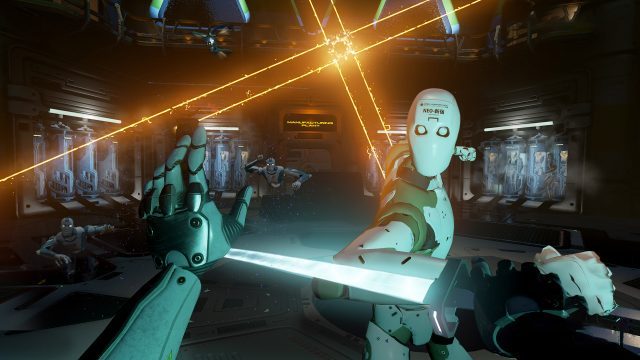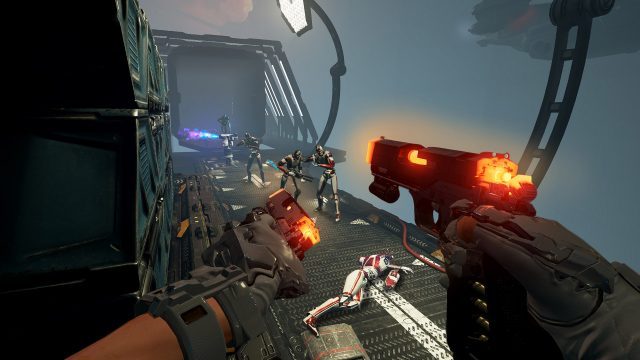Raw Data (2016) launched more than a year ago in Early Access. Following a number of major updates including the addition of a PVP mode, the game is set to hit version 1.0 and launch out of Early Access on October 5th on Rift and Vive, are will also come to PSVR for the first time on October 10th. At an event this week developers behind the game shared a range of interesting player metrics that informed the development of the game.
Speaking at VRDC Fall 2017 this week, Survios CTO Alex Silkin and Design Director Mike McTyre stressed to VR developers in the crowd that collecting proper player analytics should be a major priority. The pair said that it was a mistake to wait as long as they did before they began collecting and analyzing player data from Raw Data, but once they did they found a number of major surprises that disrupted their understanding of how players were playing, and prompted them to make changes.
What Players Want and What Players Do Can Be Radically Different
Silkin and McTyre said that some of the most vocal changes players were requesting of the game turned out not to be as popular as they might have thought. Among those consistent requests from the community were more maps/missions and PVP.
As they looked into the data, the team was surprised to find that only 21% of players had gone past the 5th mission in the game, despite there being more than 10 levels total.
As for PVP, a massively requested feature—which the pair said took a lot resources for development and maintenance—only 13% of players have given it a try.
About 80% of players played only the single-player mode, and while cooperative play was billed as a major selling point to the game, only 17% of players have played that mode.
Players Not Playing as Intended


In Raw Data players can make use of Defenses, deployable objects like turrets and force shields, an important part of the player’s survival tool kit. Yet the team found that just 1% of players were even using them! ‘Powers’ and teleportation were also underutilized, prompting the developers to add a helper system to remind players about all the capabilities at their disposal.
When it came to the launch of one of one of the game’s new heroes, the developers thought players would be excited to play as ‘Boss’, the shotgun wielding street merc. But the data showed a palty 7.5% of players were choosing him. The team discovered that some of his abilities were overly complex and players weren’t using them, making the hero feel weaker than the others. The devs ended up altering the way the hero played to make him easier to understand and a more attractive choice.
Rift vs. Vive Population and Preferred Controls
Among the two headsets, there’s a clear trend among the three control schemes offered in the game:
- Sticky: Click Grip buttons once to pick up a weapon or object. It will remain in your hands until you interact with another item.
- Toggle: Click Grip buttons once to pick up a weapon or object. Click Grip buttons again to drop it.
- Hold: Click and hold Grip buttons to pick up and use a weapon or object. Releasing the Grip buttons will make you drop the item.
Vive
- Sticky: 79%
- Hold: 3%
- Toggle: 18%
Rift
- Sticky: 21%
- Hold: 72%
- Toggle: 7%
The developers said this makes it clear that user preference in control schemes can vary drastically from one platform to the next, so providing options is important.
Marketing Tips
As Raw Data is one of the best selling VR games to date, it’s probably worth heeding the following advice. When it comes to selling your game, Silkin and McTyre said that customers respond well to bundled deals (where multiple games are discounted together). “Bundle often,” was their suggestion.
The duo also said that platform-wide sales events drive spikes in sales too, like when Steam or Oculus Home has a seasonal or holiday themed sales. Silkin and McTyre encouraged developers to participate in those sales since they drive lots of user traffic to the storefronts. “You might be surprised at what a simple $2 or $3 discount can do,” said Silkin.
And, of course, the pair said developers should strive to be on as many VR platforms as possible. That’s important given the size of the VR marketplace right now. And with new platforms like Windows VR launching soon, developers should plan from the start to be multi-platform with as little porting work as possible so that they can reach as wide an audience as possible.
– – — – –
Survios credited video game analytics firm Exostatic for helping to implement and analyze Raw Data metrics.

